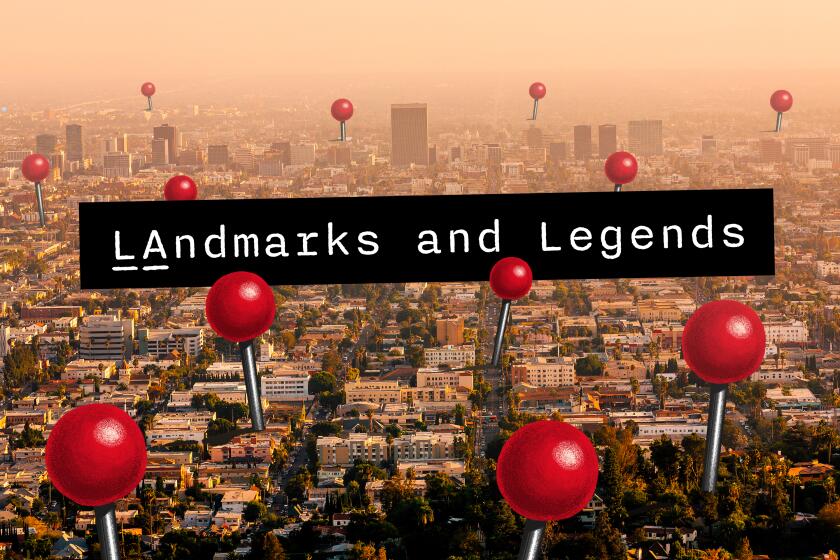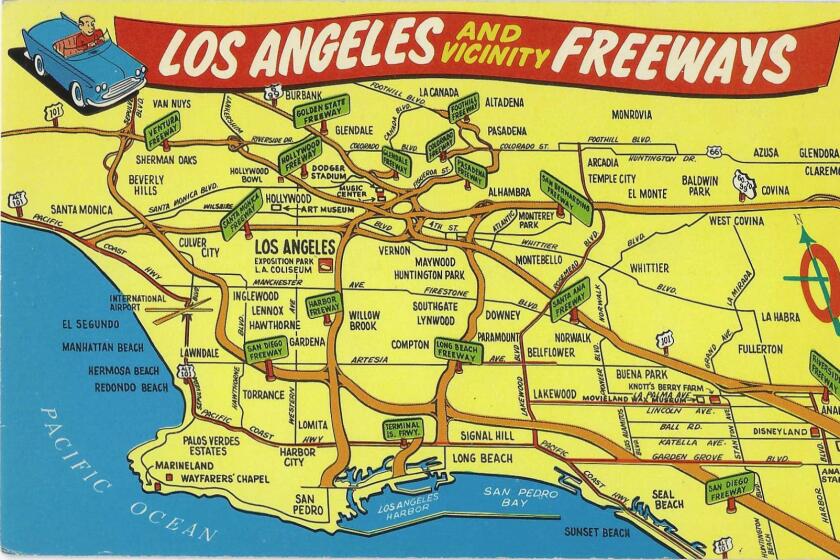The impending death of the SigAlert — and why it’s our fault

- Share via
We killed Loyd Sigmon twice.
The first time, the universe killed him — in the cosmic fashion of the universal adios, that is, for someone who was 95 years old.
But his second death? We did that. Death at the hands of tech. Death by erasure. Death by us trusting apps over our own brains.
No denying it — the driving-directions app that bosses you around on the road is squeezing the life out of Loyd Sigmon’s name and his namesake baby, that fine Southern California creation, the preserver of life and saver of time: the SigAlert.
A SigAlert is the Caltrans heads-up to two- and four-wheelin’ Southern Californians that there’s an unexpected highway or freeway snafu that will be lasting at least half an hour — so make your way accordingly.
Lots of broadcasters once carried regular traffic reports, and some still do. A few local TV stations’ newscasts will send you off to work or home or for an evening out with roadway updates. And if you’re already on the move, radio stations do the same — but fewer than there used to be.
Get the latest from Patt Morrison
Los Angeles is a complex place. Luckily, there's someone who can provide context, history and culture.
You may occasionally receive promotional content from the Los Angeles Times.
KIIS and KFI are among those that are still in the traffic mix, and KNX delivers its “traffic on the fives” reports. Yet the most sought-after traffic news is found on K-APP — phone apps.
But they’re mostly sans Sig. As people turn away from terrestrial radio, they also move away from SigAlerts. The word entered the Oxford English Dictionary in the 1990s, but Caltrans says that as far as it can tell, “SigAlerts” just don’t show up in your average traffic apps.
It’d be a darn shame if the SigAlert word is aging out. Navigating the gorgeous mess of L.A. freeways is easier with SigAlert’s 30,000-foot view, versus a phone app’s close-quarters navigation.
Loyd Sigmon was a radio exec and part owner — along with cowboy star-mogul Gene Autry — of radio station KMPC. Sig’s baby was born 70 years ago this autumn, on Nov. 17, when he first demonstrated how it could alert any ordinary joe schmoe listening to the radio.
His red light setup was not as majestic or noble as “What hath God wrought?” — Samuel Morse’s first Morse code telegraph message 110 years before — but when you are about to face down 42,000 pounds of spilled honey as you’re hurtling down the 605 Freeway, you won’t be tuning in for poetry.
Other cities have adopted the SigAlert service, but Southern California took the SigAlert profoundly to heart and into its vocabulary; it was one of the first singularly L.A. things I learned when I came here. It’s survived a variety of spellings — Sig Alert, SigAlert, Sigalert, Sig-alert, Sig-Alert. In solitary splendor, the SigAlert even has its own traffic app, so put that in your pipe and smoke it, Waze.
Who is Griffith Park named for? What about Vasquez Rocks? The Broad? Mt. Baldy? Here are the namesakes of L.A.’s best-known landmarks.
Now let me tell you the SigAlert story, before it fades to blacktop.
Loyd Sigmon was born in 1909, the year that Guglielmo Marconi and Karl Ferdinand Braun split a Nobel Prize for “their contributions to the development of wireless telegraphy.”
At military school in Missouri, the other boys nicknamed Sigmon “Radio Bug.” He took “Sig” as his amateur-radio handle. One Christmas, he made his father a crystal radio receiver set that the folks at home said was at least as good as anything that Atwater Kent or Stromberg-Carlson had on the market.

In his late 20s, he was working as an engineer in Kansas City at a station owned by MacMillan Petroleum Co. — which managed to land the local call letters KMPC. The bosses wanted him to work in L.A., and enticed him with a ticket west, a rented convertible, a reservation at the Beverly Wilshire and another at the Brown Derby.
Soon, though, the attack on Pearl Harbor put him in uniform and sent him to Europe , where he ended up heading communications for the Supreme Allied Command. His creation, the SigCircus, was a truck-mounted mobile radio broadcasting unit that shuttled messages between the U.S. and Europe — and reputedly between the White House and Downing Street. By war’s end, he was a lieutenant colonel, and he came back to L.A. persuaded that America needed to keep its peacetime ears on a wartime footing.
His first demonstration of the fledgling SigAlert system, in November 1954, was for an audience of military and civil defense officials. His pitch: We should all be forewarned if the enemy’s H-bombs are heading our way.
But even with a Cold War on, they cold-shouldered Sigmon’s baby. He took it next to law enforcement, and it was a hit: a push-button alert that could put emergencies on radio airwaves to millions in moments, a low-tech version of the way people see Amber Alerts now.
There is no Beverly Hills Freeway. Nor does the 2 connect to the 101. What even is the 90? These are the freeways that didn’t happen as planned.
Here’s how it worked: Any number of law enforcement officials could call in their emergencies to a police dispatcher, who recorded the information on Sigmon’s receiver-tape recorder device. The dispatcher then used a red light and a special “subcarrier” tone to alert radio station engineers that the announcement was ready for broadcast, and radio stations broke into their programming to air it, with the words, “THIS IS A SIGALERT BULLETIN.”
The first SigAlert was issued on Labor Day 1955, a Monday, over the six radio stations that had signed up. A train had derailed at Union Station, and nurses and doctors were needed. So many showed up that the crowds created their own minor hazard.
Early SigAlerts had rather a small-town feel, like a town crier. In the first three months, 86 SigAlerts were issued, only 36 of them for traffic mangles.
The rest were warnings about rabid dogs, warnings to specific people that their pharmacists had accidentally concocted potentially fatal prescriptions, warnings about pending air-raid siren tests, a caution about a flasher on a certain street corner, and one ship collision in the harbor.

In December 1963, a SigAlert told Baldwin Hills residents that the dam in the hills above them was about to break, and it undoubtedly saved lives. A teenage boy on a bicycle was hit by a car, and with only his school ID to identify him, a SigAlert went out, and a woman who heard the boy’s description recognized him and connected police with the boy’s mother.
Those early sets cost about $600. They were initially produced by Packard-Bell working with Sigmon’s company, Federal Electronics Corp. The Long Beach Independent called it a “neat case” of 9-by-8-by-7 inches that plugged handily into a wall outlet. Within a year, four dozen California cities and others in Arizona and Nevada were on board for the SigAlert system.
Deep down, Sigmon admitted, he thought of this as a way to drive listeners to KMPC. But when he took his device to LAPD Chief William Parker, the chief said he’d adopt it — but it had to be available to every station. No competitive advantage. By way of consolation, so the story goes, Parker named the system SigAlert.
In 1965, on the 10th anniversary of the SigAlert and its 10,000-alert mark, KTLA devoted a half-hour TV tribute to Sigmon and his baby.
The California Highway Patrol took over the system’s operation in 1969 and still uses it for bad smash-ups and for the late-night-comedian kind of truck spills: thousands of gallons of hot tar, 2 tons of cantaloupes, 20 tons of plywood, a load of brassieres, a whole house still swagged in Christmas lights, an old-fashioned outhouse (unoccupied), $7,000 in quarters, and a body from a coroner’s van.
KTLA, KFWB, KTTV, KNX — you know the call letters of local radio and TV stations and probably have a jingle or two stuck in your head. But where did this broadcasting alphabet soup originate?
Sigmon himself drove a white Cadillac with the license plate SIGALRT, and moved out of L.A. traffic permanently, to Oklahoma, in the spring of 2000, where he died in 2004.
He and his SigAlert fathered hosts of airborne Los Angeles traffic reporters, gifted with vivacity and great eyesight.
KIIS had “Commander Chuck Street,” KTLA had Jennifer York. Future TV news anchor Kelly Lange was hired as airborne “Dawn O’Day” for morning traffic helicopter rush-hour duties for KABC radio. (Her afternoon counterpart was called Eve O’Day.) It was radio, but the station put Lange in a form-fitting silver lamé jumpsuit with knee-high silver boots.
KFI had “Bruce Wayne, KF-Eye-in-the-Sky,” and KNBC television had helicopter pilot Francis Gary Powers.
Wayne spent nearly 25 years as an airborne traffic reporter. He died in 1986, when his Cessna crashed on takeoff.
And Powers and cameraman George Spears died in a crash in the San Fernando Valley in August 1977, returning from shooting footage of brush fires near Santa Barbara. He was that Francis Gary Powers, the Air Force officer piloting a U2 spy plane that the Russians shot down in 1960. A prisoner exchange returned Powers to the West, and in time he made his way to Los Angeles.
Explaining L.A. With Patt Morrison
Los Angeles is a complex place. In this weekly feature, Patt Morrison is explaining how it works, its history and its culture.
More to Read
Sign up for Essential California
The most important California stories and recommendations in your inbox every morning.
You may occasionally receive promotional content from the Los Angeles Times.














